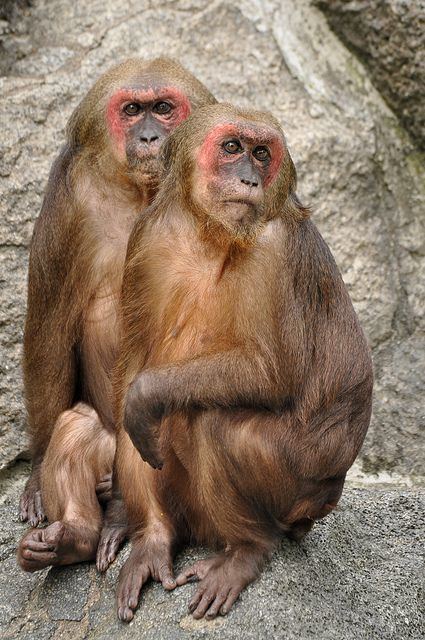Scientific name Simiiformes Speed Human: 45 km/h | Phylum Chordata Higher classification Haplorhini | |
 | ||
Infraorder SimiiformesHaeckel, 1866 Lifespan Human: 79 years, Bonobo: 40 years Height Human: 1.7 m, Bonobo: 1.2 m, Mandrill: 55 – 65 cm Mass Bonobo: 34 – 60 kg, Common chimpanzee: 40 – 60 kg Lower classifications Gorilla, Chimpanzee, Ape, Orangutan, Macaque | ||
The simians (infraorder Simiiformes, Anthropoidea) are the monkeys, cladistically including the apes: the New World monkeys or platyrrhines, and the catarrhine clade consisting of the Old World monkeys and apes.
Contents
The simian line and the tarsier line diverged about 60 million years ago (during the Cenozoic era). Forty million years ago, simians from Africa colonized South America, giving rise to the New World monkeys. The remaining simians (catarrhines) split 25 million years ago into apes and Old World monkeys.
Classification and evolution
In earlier classification, New World monkeys, Old World monkeys, apes, and humans—collectively known as simians or anthropoids—were grouped under Anthropoidea (/ˌænθɹoˈpɔɪdiə/, Gr. άνθρωπος, anthropos, human, also called anthropoid apes), while the strepsirrhines and tarsiers were grouped under the suborder "Prosimii". Under modern classification, the tarsiers and simians are grouped under the suborder Haplorhini while the strepsirrhines are placed in suborder Strepsirrhini. Despite this preferred taxonomic division, prosimian is still regularly found in textbooks and the academic literature because of familiarity, a condition likened to the use of the metric system in the sciences and the use of customary units elsewhere in the United States. In anthropoidea, evidences indicate that the Old and the New World primates went through parallel evolution.
Primatology, paleoanthropology, and other related fields are split on their usage of the synonymous infraorder names, Simiiformes and Anthropoidea. According to Robert Hoffstetter (and supported by Colin Groves), the term Simiiformes has priority over Anthropoidea because of the taxonomic term Simii by van der Hoeven, from which it is constructed, dates to 1833. In contrast, Anthropoidea by Mivart dates to 1864, while Simiiformes by Haeckel dates to 1866, leading to counterclaims of priority. Hoffstetter also argued that Simiiformes is also constructed like a proper infraorder name (ending in -iformes), whereas Anthropoidea ends in -oidea, which is reserved for superfamilies. He also noted that Anthropoidea is too easily confused with "anthropoïdes", which translates to "apes" from several languages.
The simians are split into three distinct groups. The New World monkeys in parvorder Platyrrhini split from the rest of the simian line about 40 mya, leaving the parvorder Catarrhini occupying the Old World. This group split about 25 mya between the Old World monkeys and the apes. "Monkeys" are a paraphyletic group (in other words, not a single coherent group).
Classification
The following is the listing of the various simian families, and their placement in the order Primates:
